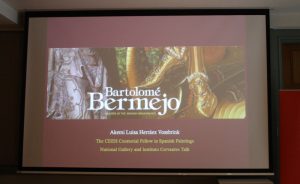Bartolomé Bermejo, the great painter of the Crown of Aragon, seduces in London

The curatorial fellow of the National Gallery exhibition “Bartolomé Bermejo. Master of the Spanish Renaissance”, Akemi Herráez Vossbrink, gave a lecture on the life and work of this Spanish painter, organized by Instituto Cervantes in London in collaboration with the National Gallery.
Bartolomé Bermejo (h. 1440-h. 1501), a Spanish Master from Cordoba who worked in the territories of the Crown of Aragon, was one of the most fascinating personalities of the artistic panorama of the second half of the fifteenth century. He led an itinerant lifestyle, working in Valencia, Tous, Daroca, Zaragoza and, finally, Barcelona.
“It is incredible to have seven of his works here. This will probably not happen again in a long time,” said Herráez, in relation to the exhibition in the British capital, which will remain open until September 29. In addition, the director of Instituto Cervantes in London, Ignacio Peyró, highlighted “the exceptional thing about having, in such a short space of time, Murillo, Sorolla and Bermejo, three Spanish painters, in a world-class institution such as the National Gallery”.

Herráez’s lecture focused on the seven paintings in the exhibition, analysing their context and considering them within the development of Bermejo’s artistic career. Among them, the “Saint Michael”, “The Virign of Montserrat” and the “Pietà Desplà” received special attention comparing their patrons, craftsmanship, location and historical context.
“Saint Michael” is Bermejo’s only work on British soil, while the rest of the pieces in the exhibition travelled to London for the first time for this occasion. An exceptional occurrence, other paintings such as “The Virgin of Montserrat” and “Pietà Desplà” had not previously been moved for almost 500 years from their respective cathedrals of Acqui Terme and Barcelona.
A few years ago, the National Gallery restored the painting “Saint Michael triumphant over the Devil with the Donor Antoni Joan.” This restoration highlighted Bermejo’s masterful technique, mixing features of Flemish and Spanish painting, in a painting that has no equal among his Spanish contemporaries.
The exhibition takes place in London, after two major Bermejo exhibitions were held recently at the Prado Museum in Madrid and at the National Museum of Art of Catalonia (MNAC) in Barcelona, both showing around 48 pieces from different periods of Bermejo’s career, including works by the master, his contemporaries, copies and other comparative objects.

Warm welcome
Bermejo’s exhibition at the National Gallery, directed by Gabriele Finaldi and with Letizia Treves as the main curator, has been well received by the British public over the course of the summer. Many of the visitors recognized the “Saint Michael”, which they had seen for years in the National Gallery, but now they can admire it in its restored form.
“Previously, many details of the plants had been lost, it was quite brown and, most noticeably, the gold above had been practically lost. Before the exhibitions, a conservator, an external gilder and the scientific team here restored it, and thanks to that, we were able to start the project. A technical essay was written on the investigations that were done at the time and published in the London exhibition catalogue dedicated exclusively to Saint Michael and its context,” added Herráez.
Herráez also believes that the public is fascinated by Bermejo’s attention to detail, especially by the animals and plants. “It’s something that the public loves, as well as the comical aspect of the demons.”


